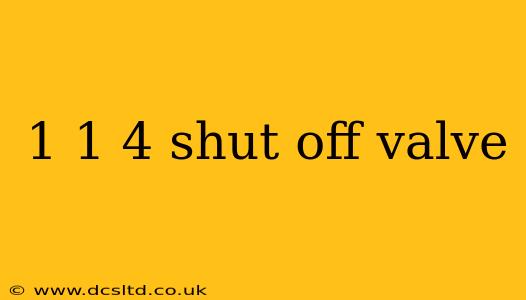Shut-off valves are essential components in various plumbing and industrial systems, controlling the flow of liquids or gases. A 1 1/4" shut-off valve, specifically, is commonly used in applications requiring a relatively large flow capacity. This comprehensive guide delves into the intricacies of these valves, exploring their types, applications, and maintenance.
What is a 1 1/4" Shut-Off Valve?
A 1 1/4" shut-off valve is a valve with a nominal pipe size of 1 1/4 inches. This refers to the inner diameter of the pipe the valve is designed to fit. The "shut-off" designation indicates its primary function: to completely stop or start the flow of a fluid (liquid or gas) within a pipeline. The size dictates its flow capacity; a larger diameter allows for greater flow rates than smaller valves.
What are the Different Types of 1 1/4" Shut-Off Valves?
Several types of 1 1/4" shut-off valves exist, each with its own advantages and disadvantages. The choice depends heavily on the specific application and required performance characteristics.
Ball Valves:
Ball valves are known for their quick on/off operation and relatively compact design. A rotating ball with a hole through its center controls the flow. They are durable and offer a tight seal, making them suitable for various applications.
Gate Valves:
Gate valves use a gate or wedge to obstruct the flow. They are generally used for fully open or fully closed positions, not for throttling flow. Gate valves are suitable for large diameter pipes and offer low pressure drop when fully open.
Globe Valves:
Globe valves regulate flow by means of a disc that moves up and down within a casing. They are well-suited for throttling applications, allowing for precise flow control. However, they tend to have higher pressure drops compared to ball or gate valves.
Butterfly Valves:
Butterfly valves feature a disc that rotates to control flow. They are compact and offer good flow control, but sealing can be less precise than ball valves, particularly at higher pressures.
Where are 1 1/4" Shut-Off Valves Used?
The applications for 1 1/4" shut-off valves are extensive and span various industries:
- Plumbing Systems: Controlling water flow in residential, commercial, or industrial plumbing.
- Irrigation Systems: Regulating water flow to different zones or sections.
- Industrial Processes: Controlling the flow of various fluids (chemicals, gases, etc.) in manufacturing and processing plants.
- HVAC Systems: Managing the flow of refrigerant or other fluids.
- Fire Protection Systems: Isolating sections of piping in case of emergencies.
How to Choose the Right 1 1/4" Shut-Off Valve?
Selecting the appropriate 1 1/4" shut-off valve involves considering several factors:
- Fluid Type: The compatibility of the valve material with the fluid is crucial. Some valves are designed for specific fluids or temperature ranges.
- Pressure Rating: Ensure the valve can withstand the operating pressure of the system.
- Flow Control Needs: Determine whether you need a simple on/off valve or one that provides throttling capabilities.
- Material Compatibility: Choose valve materials (brass, stainless steel, PVC, etc.) that are compatible with the fluid and the operating environment.
- Installation Requirements: Consider space constraints and the ease of installation.
How Do I Maintain a 1 1/4" Shut-Off Valve?
Regular maintenance is key to ensuring the longevity and proper functioning of your 1 1/4" shut-off valve.
- Regular Inspection: Periodically check for leaks, corrosion, or damage.
- Lubrication: Some valves benefit from periodic lubrication to ensure smooth operation.
- Cleaning: Clean any debris or buildup around the valve.
- Professional Service: Consider professional service for more complex issues or if you notice any irregularities.
This guide provides a comprehensive overview of 1 1/4" shut-off valves. Remember to always consult manufacturer specifications and follow safety guidelines when working with valves and plumbing systems. For specific applications, it's recommended to seek advice from a qualified plumber or engineer.
